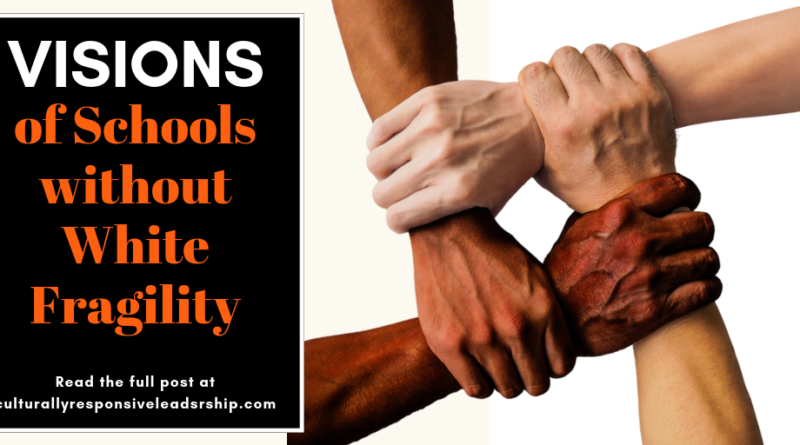Visions of Schools without White Fragility (4/4)
A racism-free school may not be coming any time soon, but we can address white fragility. But how do we move past the theoretical to the practical? What are we really working towards? What does an anti-racist school look like, sound like?
(This is an additional 4th part of a series focused on White Fragility in Schools. See Part 1: for background knowledge about the book, Part 2: on What Leaders can do about White Fragility, and Part 3: a White Leader’s reflection on addressing White Fragility)
For some framing, Glenn Singleton clearly explains a plan for how we can have more courageous conversations about race, including his famous compass and 4 agreements. Below is a great video of him breaking it down. If you check out his book, he also shares norms, processes, and lots of stories about how to approach this work.
This post, however, is about what we are working towards, and what might happen, if we get there.
A Vision of Racial Equity in Action
A few weeks ago, I was talking with my co-worker and close friend, Kevin Odle. He asks me “what does it really mean to be anti-racist?” and “what would that look like in a school?” We talked for about a half hour and we both got a lil clearer on what that would look like. We realized that we have both been doing work together, vaguely moving towards this vision, without naming it outright. We also didn’t list what that looks like in real time, with real people, in a real school. Ironic that we both are leaders in a real school. Ha. I mean how can we get there if we don’t know where there is? This got me thinking.
What is a vision of a school without White Fragility?
It’s still ok to dream isn’t it?
Normalizing Racial Dialogue
I first heard Dr. Ammar Saheli breathe fire at a training for SFUSD Administrators, 4 years ago, and I hoped to be like him one day. Ammar is a Racial Equity Leader and an Author of the new book, Eerie Silence. I reached out to this brother, for his take on white Fragility and our work. Here are his thoughts about how we get there.
“In my systematic work of seeking to disrupt and ultimately dismantle the toxic elements of whiteness, white supremacy, and white privilege within educational realms, I move toward the intervention and creation of space where racial dialogue is normalized. I make it clear that we cannot conflate racial dialogue normalization with comfort. Based on racial constructions in America, the racial dialectic process is never comfortable, but we must push for its normalization over racial discomfort. In my work with white educators and beyond, the trajectory is set toward normalizing racial discussion because racialized social justice actions and solutions cannot commence without first embracing holistic, risky, vulnerable, honest, and bold racial dialogue.” See more Ammar Saheli’s work on his website.
Ammar is right on. We need to normalize this work. But it is hard to make anything the norm when it’s unclear. Reflecting on my previous work, I realize that I have been hella passionate but far too vague. The vision was pretty clear in my mind but my articulation of has been general and opaque. This led to confusion, resistance, and limited outcomes. In addition, it was hard to make intentional moves and measure our progress. It didn’t matter how much time we were spending in meetings, discussions, and reading articles. Each time, some folks experienced it as temporary work, “another thing”, and oftentimes non-essential. I believe that the foundation of all of this was an unclear vision.
So, What would it LOOK like without White Fragility
White staff would actually talk about race. Shocking, I know but for real this time. Imagine. And, not just the intellectual conversation about race, but instead how race informs their work. African American, Latinx staff would feel comfortable being honest about what they see and what they want. Folks would lean (physically and metaphorically) into the conversation; they would ask questions. We would all be curious.
Further, we might see white folks leading the conversation, carrying the weight of the conversation, asking provocative questions to the group. We would see nodding, affirmation, and eye contact. Also, people would be sitting in circle, face to face. Not just to do small talk, but to talk big, go deep, and talk about action.
Imagine that shit.

In a White Fragility-free School, We Might Hear:
- “That triggered me.”
- “That was a microaggression. It made me feel belittled.”
- “I think we can do better for our Samoan students”
- “That is not consistent with our norms of valuing every member of our community.”
- “We have been only speaking about black students and how they need to act better, what can we do better, so they learn more.”
- “All our recent suspensions have been of our Latino boys, what does that say about our bias?”
- “As a Latina I want to connect better with my Tongan students, but I want to find overlaps in our cultures.”
- “How can we take a collectivist approach to this problem?”
- “As a white man, I want to create more space for our staff of color to speak.”
- “I realize that race is still a blind spot for me.”
- “It pains me to realize that my white ancestors profited and benefited off the forced labor of enslaved Africans, and I wanna know what I can do today about that.”
- “How can I be more supportive?”
How and when do you as a Leader share this vision?
Often!
It should be a part of your multi-year strategic plan and annual theory of action. This will allow for it to be supported with resources, training, and ultimately measured for success.
Furthermore, an anti-racist vision can be referenced at the start of meetings using an equity frame (post coming on this soon). The beginning of a meeting is a time to recall the mission, stoke the flames of passion. Tug on the heartstrings.
When starting racial equity work, it is also important to share your vision and to have team members reflect on what we are all working towards (with respect to race). Finally, this has implications for creating powerful anti-racist or brave norms.
Share your Vision More than Once a Year
Note, that even if you have shared your vision, with fancy pictures, songs, dyads, and memes, it didn’t sink in the first time. It wasn’t enough. Some people thought you were selling wolf tickets. Others thought you were mandated to do it and “this too shall pass.”
But race ain’t going nowhere baby.
And Racial Equity is not a fad. This means you need to make it commonplace, as Saheli stated. Normalized. Practice makes perfect and since we are hella far from perfect, we need a gang of practice.
As a leader, you need to be ready to answer the question: what are you/we working towards and what does it look like? You will be asked, again and again. See, folks want to know if you are bout it bout it, or if you doubt it. It helps to shout it, at least figuratively.
Conclusions
Your team, your staff, your students, and your community need to know what you are committed to. Don’t dumb it down neither. The work of racial equity, social consciousnesses, and social justice is complex.
It’s more than being nice, “respecting all perspectives,” or random acts of equity. We need to go deep. It’s supposed to be messy, but it helps if we know generally where we are going. We have to work through it. We can work through it. Just make sure people know why and where they are headed.
And one more thing. Folks will say that it is “your” work, call it “that equity work,” or “what the Principal says we ‘have’ to do.” This happens until you give folks enough time to explore and work through the muck. Until their is enough understanding, it’s easy to put it all on the leader. The disassociation and deflection of ownership is comfortable, and if done right, temporary.
Because after deeper work, coming back to it, and showing that it is important, “your work,” will become “our work.” That is when the real magic happens. Then folks will want to take it the next level, take lead, and measure success. That starts with a vision.


